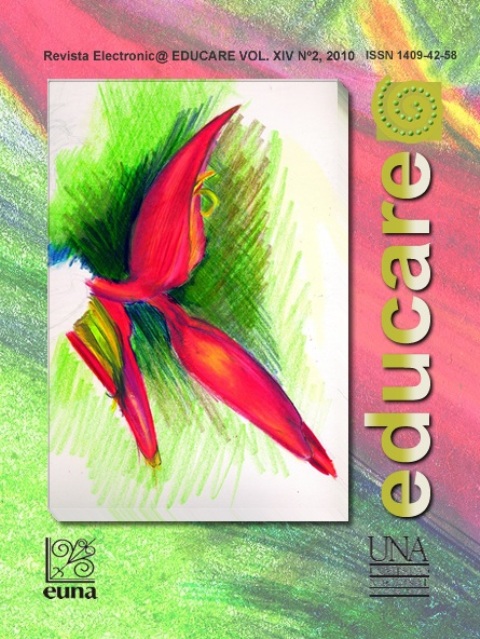The Creative Spirit: a Research Experience in Higher Education
DOI:
https://doi.org/10.15359/ree.14-2.3Keywords:
research experience, creativity, didactic, diagnostic evaluation, formative evaluationAbstract
This article presents a research experience carried out during the first 2009 period with students of the General Didactic course at the Universidad de Costa Rica, Sede de Occidente. This experience intends to motivate students’ creativity for the construction of their own didactic, through the development of two course objectives: to analyze didactic action from different approaches and to determine the relationship between didactic and educational innovations, and its association with professional culture. Diagnostic, formative and summative evaluations were used as a strategy to assess the experience.
References
Bertoni, A., Poggi, M y Teobaldo, M. (1995). Evaluación de nuevos significados para una práctica
compleja. Buenos Aires: Editorial Kapeluz.
Betancourt, J. (1999, Julio-Septiembre). Creatividad en la educación: Educar para transformar.
Revista Educar, Número 10, s. p. Recuperado de http://educar.jalisco.gob.mx/10/10julian.
html
Betancourt, J. (2000). Creatividad en la educación: Educación para transformar. Revista Electrónica
Psicología Científica.com. Recuperado de http://www.psicologiacientifica.com/bv/psicologia-
-1-creatividad-en-la-educacion-educacion-para-transformar.html.
Crawford, R. (1989). Las técnicas de la creatividad. En G. Davis & J. Scott (Orgs.). Estrategias para
la creatividad, (pp. 7-12). México: Paidós Educador.
Díaz, F. (2002). Didáctica y Currículum: un enfoque constructivista. Cuenca: Ediciones de la
Universidad de Castilla.
Frabboni, F. (1998). El libro de la pedagogía y la didáctica I. La educación. Madrid: Editorial
Popular.
Goleman, D. (2000). El espíritu creativo. Madrid: Vergara.
Hallman, R. (1989). Técnicas de enseñanza creativa. En G. Davis & J. Scott (Orgs.). Estrategias
para la creatividad, (pp. 12-13). México: Paidós Educador.
Libeliy, P. (1993). Creatividad y Universidad, ¿Qué tal pareja son? DIDAC. Reflexiones sobre la
educación. 2 J. Primavera’ 93. Consultada en http://www.uia.mx/web/site/tpl-Nivel2.php?men
u=mgPublicaciones&seccion=puDidac
Marín, I. (1982). Principios de la educación contemporánea. Madrid: Rialp.
Parnes, S. (1989). ¿Puede incrementarse la creatividad? G. Davis y J. Scott (Orgs.). Estrategias para
la creatividad, (pp. 8-9). México: Paidós Educador.
Soriano, E. (2009, Julio-Septiembre). La educación para la creatividad. Revista Educar,
Vadillo, G. y Kingler, C. (2004). Didáctica. Teoría y práctica de éxito en Latinoamérica y España.
México: Editorial Mc Graw Hill.
Wang, M. (1994). Atención a la diversidad del alumnado. Madrid: Narcea.
Downloads
Published
How to Cite
Issue
Section
License
1. In case the submitted paper is accepted for publication, the author(s) FREELY, COSTLESS, EXCLUSIVELY AND FOR AN INDEFINITE TERM transfer copyrights and patrimonial rights to Universidad Nacional (UNA, Costa Rica). For more details check the Originality Statement and Copyright Transfer Agreement
2. REUTILIZATION RIGHTS: UNA authorizes authors to use, for any purpose (among them selfarchiving or autoarchiving) and to publish in the Internet in any electronic site, the paper´'s final version, both approved and published (post print), as long as it is done with a non commercial purpose, does not generate derivates without previous consentment and recognizes both publisher's name and authorship.
3. The submission and possible publication of the paper in the Educare Electronic Journal is ruled by the Journal’s editorial policies, the institutional rules of Universidad Nacional and the laws of the Republic of Costa Rica. Additionally, any possible difference of opinion or future dispute shall be settled in accordance with the mechanisms of Alternative Dispute Resolution and the Costa Rican Jurisdiction.
4. In all cases, it is understood that the opinions issued are those of the authors and do not necessarily reflect the position and opinion of Educare, CIDE or Universidad Nacional, Costa Rica. It is also understood that, in the exercise of academic freedom, the authors have carried out a rogorous scientific-academic process of research, reflection and argumentation thar lays within the thematic scope of interest of the Journal.
5. The papers published by Educare Electronic Journal use a Creative Commons License:














 The articles published by Educare Electronic Journal can be shared with a Creative Commons License:
The articles published by Educare Electronic Journal can be shared with a Creative Commons License: 



